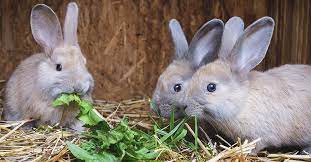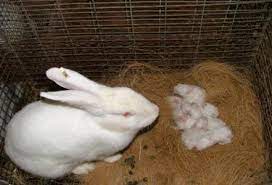Breeding Methods in Rabbit Keeping
Reproduction including rabbit reproduction is a process of giving birth, is a complex process controlled by many substances called hormones which are produced in endocrine glands in the body, and in other parts of the body like the ovaries.
Hormones are produced in very small amounts. They are transported to the organ they controlled (target organ) by the blood circulation system.
Different hormones act on different parts of the reproductive system at different times to ensure successful reproduction.
1. Selection for Breeding
Breeding stock should be selected from does who are good mothers and who have good body size and shape. Also to be considered is the live weight of the rabbits, select the heaviest but take account of any differences in age if selecting from more than one litter.
In the size of the litter of which the rabbit is a member, give selection preference to rabbits from the largest litters if there are enough liters to give a choice. Select rabbits free of any signs of ill-health. Males should be checked to confirm that each has two testicles in its scrotum.
2. Mating
On forage based systems, does are normally ready for mating at about 8- 10 months. At this age their growth will be slowing and they will be able to direct a larger portion of available food to reproduction.
The weight at mating varies according to breed. Effort should be mad to determine the optimum weight for mating for any breed in question. The same applies to bucks as to does, but bucks can usually be used for mating from six to eight months, depending on the condition.
The ratio of does to bucks should not exceed 10:1. However, for safety, it may be sensible to have two bucks for more than six does and three for more than twelve.
Read Also : How to Care for Newly Weaned Rabbits Properly
Experience has shown that early morning or evening mating is best. It is advisable to avoid the hottest periods of the day.
For mating, the doe should be taken to the buck’s hutch if it is done the other way round the doe may attack the buck and cause injury. If the doe is ready to be mated she will stand still within a few seconds, stretch out and slightly raise her hind quarters so as to allow the buck to mount and mate.

Successful mating is signaled by the buck thrusting forward and literally falling off the doe. This is very easy to see. If the buck slides backwards off the doe and does not fall, then mating has not taken place.
Once mating has taken place the doe is removed from the buck’s hutch. The doe may be returned after an hour or so for a second mating. This is a good practice for new keepers to follow.
3. Care of Does during Pregnancy
Pregnant does will often accept the buck during pregnancy, so refusal to mate cannot be used to confirm pregnancy. The first real confirmation of pregnancy can be obtained at about 14 days after mating.
The doe should be relax and sitting naturally. If fingers are then gently run along the abdomen, between the back legs small bead-like lumps can be felt if the doe is pregnant these are developing fetuses.
Inexperienced keepers should practice detecting pregnancy in does that are 20 days pregnant, at which stage the fetuses are easy to identify.
By around 28 days the mammary gland will have developed significantly and this can be regarded as final confirmation of pregnancy.
At around 29 days the doe will begin to remove fur from her abdomen to make a nest. Pregnancy or gestation is the time from fertilisation to the time of kindling or parturition which takes 31 or 32 days.
On the average, pregnancy period lasts 30 days in the common commercial breed. During this period the doe should be well fed and protected from stresses such as dogs and general noise.
4. Gestation Period
This is the time from fertilization to the time of kindling or parturition which takes 31 or 32 days.
On the average, pregnancy period lasts 30 days in the common commercial breed. About four to five days before kindling a nesting box should be brought in with some wood shaving of fine straw placed on the floor of the box.
It will soon be found that the doe begins to remove hair from her abdomen and sides and place them in the box to prepare a warm cushion for the young ones soon to be born.
The young ones of rabbit are born naked and blind. Their mother uses the hairs in the box to cover them to keep warm.
5. Kindling
The doe usually kindles or gives birth, at night. Once kindling has finished the doe will pluck more fur from her abdomen and cover the young rabbits.
It is best to leave her undisturbed for two to three days after kindling unless there are obvious problems.
It is a good practice to have some cotton wool ready to cover the litter if the doe has not done this properly herself.
6. Weaning
Weaning is the separation of the doe and the young. It should be done around six to eight weeks after kindling. The best method of weaning is to take the doe away from the litter. To do it the other way round will put too much stress on the litter.
The period after weaning is another critical time for the young rabbits and it is a time for feeding some concentrates if available. Small amounts of concentrate at this time will have a big effect on growth rate.
As the rabbit grow they may be gradually taken off concentrates but their growth rate will slow as a result. The litter will soon require extra hutch space.
After weaning, the doe should be allowed time to recover her body condition before re- mating.
Weekly weighing is the only sure method of checking that she is regaining her body reserves. Does can continue breeding until they are three to four years old.
In summary, reproduction is a complex process controlled by substances called hormones. Breeding stock should be selected from does who are good mothers and who have good body size and shape to ensure healthy offspring.
Reproduction is a complex process controlled by substances called hormones which are produced in endocrine glands in the boy, and in other parts of the body like the ovaries.
Hormones are transported to the organ they controlled (target organ) by the blood circulatory system.
The female reproductive system consists of the ovaries (2), oviducts or fallopian tubes (2), uteri (2), cervix, vagina, vulva and Mammary glands (8-10). While the male reproductive system consists of: the testicles (2), vasdeferens(2), Penis and associated glands.
Breeding stock should be selected from does who are good mothers and who have good body size and shape. The ratio of does to bucks should not exceed 10:1. First real confirmation of pregnancy can be obtained at about 14 days after mating.
The doe should be relax and sitting naturally. If fingers are then gently run along the abdomen, between the back legs small bead-like lumps can be felt if the doe is pregnant, these are developing fetuses.
The doe usually kindles or gives birth, at night. Sexing of rabbit can be done any time as from the moment of weaning. Weaning is the separation of the doe and the young. It should be done around 6-8 weeks after kindling.
Read Also : Recycling and Reuse Alternatives to Waste Management









